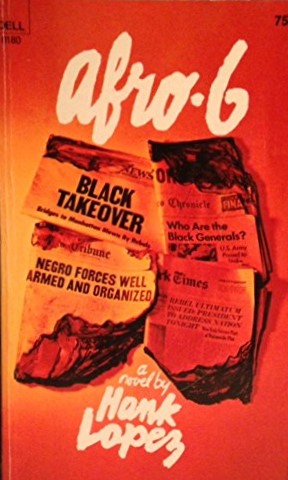Fans of “Kill Whitey” fiction of the 1960s and 70s will note that the premise of this 1969 novel is nearly identical to that of SIEGE by Edwin Corley, which was published in the same year. Given that the two novels appeared so close together I’ll refrain from making any accusations about plagiarism, but the fact that they’re so similar does somewhat blunt the effect of AFRO-6—although I nonetheless find it the more satisfying of the books.
SIEGE was about an African-American uprising that involved blowing up the bridges and tunnels connecting New York City with the mainland, the object being to pressure the U.S. government into making New Jersey a black-only haven. In AFRO-6 NYC is once again under siege by black militants, who aim to take several hundred white people hostage, with an end game that isn’t as clear as that of SIEGE’S revolutionaries. Author Hank Lopez, at least, doesn’t appear to have any pretentions to great, or even prophetic, literature, providing a fast-moving, sensation-packed narrative with a great deal of unabashed sexploitation (sexy women figure heavily, and there’s even some S&M).
The protagonists are John Rios, a dark-skinned Latino who identifies as black, and Alan Geller, a Jewish academic. The Harvard-educated Rios is tasked with overseeing the planning of Afro-6, which, as it turns out, is pulled off with remarkable ease: the elaborate bridge blowings go forth as planned, and the government even ponies up the ransom demanded for the white hostages. The only real impediment is Geller, an old college chum of Rios who suspects that something is brewing early on, when a prominent black poet dies under suspicious circumstances—in fact, said poet was murdered by Rios out of concern that he might tell the authorities about Afro-6.
It seems odd that in an operation involving hundreds (if not thousands) of people only one of them has loose lips, but (as with SIEGE) plausibility isn’t among this novel’s strengths. Rather, it works because of its panoramic scope, contained within an economic 237 pages, and its time-capsule depiction of the revolutionary tenor of the late 1960s (as elucidated by an especially incendiary Malcolm X quote that prefaces the book), when an uprising on the scale of Afro-6 seemed like a distinct possibility.

